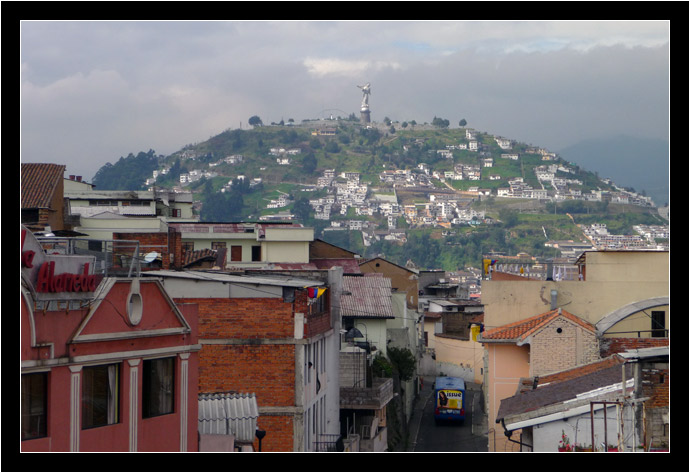
The first time I visited Ecuador was at the end of 1998. I’ve been back twice since then; once at the tail end of 2009 and again at the end of 2010. Not being very familiar with the country makes it pretty difficult to spot the changes over that timeframe (I noticed a few), but it’s fairly easy to pick out the differences between Ecuador and the United States.
Here are some of the little things I noticed:
Economy and Prices
One of the ways to gauge how inexpensive it will be to travel through a foreign country is to look at the exchange rate. Generally speaking, if one of your dollars buys a whole bunch of their currency, you can expect that your stay won’t cost you very much. That used to be true in Ecuador. When I first arrived in 1998, one US dollar bought about 6,000 sucres. By the time we left Ecuador, three months later, that same dollar gave us 13,000 sucres. Their economy was tanking.
Sometime thereafter, Ecuador decided to tie their economy to ours and opted to use the US dollar as their own currency. They refer to the changeover as “the dollarization.” We were told the process wasn’t easy for a lot of Ecuadorians – it was hard for some to grasp how having hundreds of dollars in their bank accounts was better than having millions of sucres – but now that their economy is stable, most would agree that it was a good thing.
So now the exchange rate is 1-to-1, but that doesn’t necessarily mean that the prices are the same. It’s still quite possible to travel through Ecuador on $20 a day. We’ve been paying anywhere from $7-15 per person for lodging, $2-7 per person for meals (although a $7 meal is pretty expensive), and a good rule of thumb for transportation through the country is $1 per hour by bus. Granted, this is definitely budget travel we’re talking about here.
Expats
The Ex-patriot community is booming in Ecuador. One guy I spoke with estimated that 6 people a week were joining the “official” ex-pat community in Cuenca alone. It seemed like everywhere we went, we met retired couples that were scoping out different parts of Ecuador. Most had plans to open up a B&B or a restaurant and all of them knew that their retirements would stretch much farther down there.
It makes sense. Paychecks don’t even need to be converted as the two economies are essentially tied together now. But why, all of a sudden, is Ecuador the go-to spot for North Americans looking to ex-patriate? I can think of two reasons. 1) The situation with the drug cartels in Mexico, and 2) The worldwide economic recession.
Gas Prices
Gas is super cheap in Ecuador. I thought the gas stations were displaying their prices in liters when I saw that diesel was running $1 per gallon, regular was $1.50, and the high-octane stuff only ran about $2. But then, while I was puzzling over how a 30-minute cab ride could only cost $5 or so, our explained that (for some reason) they use gallons at the gas station. The long and short of it is that the government heavily subsidizes the industry. If they didn’t, and if Ecuadorians were forced to pay the world average for gasoline prices, I’d bet you the number of cars on the roads would drop by 90%.
Sacajawea
Have you ever seen one of those gold Sacajawea US dollar coins? In the States, they’re probably rarer than the silver dollar coins with the lunar lander on the back – you know, the ones that are so easy to mistake for a quarter – but in Ecuador, the Sacajawea is the coin of the land. I dare say you’re far more likely to end up with a pocketful of gold coins than a wallet full of singles. Would it be better for us to do the same in the States? Print more dollar coins and take a bunch of bills out of circulation? I don’t know where I’d stand on that, but I sort of liked having the coins in my pocket. A refreshing change (so to speak.)
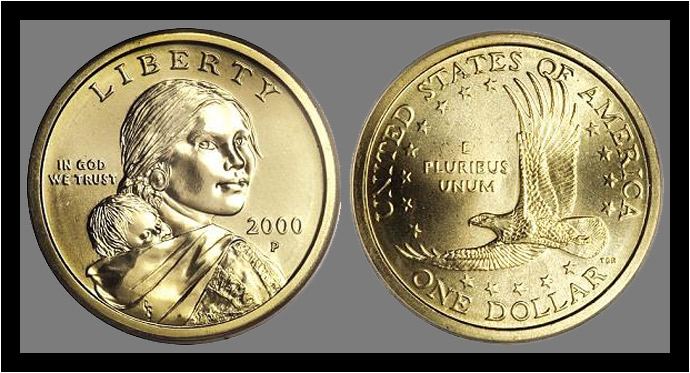
AC Outlets
Ecuador is one of the few countries I’ve traveled to that uses the same AC outlets as the States. Granted, it’s harder to find a three-prong socket, but otherwise, you don’t even need to worry about the voltage (it’s 110, like ours.) Sure made charging up all our electronics easier!
Bathrooms
Plumbing in Ecuador uses very small pipes, so flushing toilet paper down the toilet is a strict no-no. Every bathroom has a tiny trashcan where you’re supposed to deposit your used paper. (Oh! Perhaps that’s why all the toilet paper is scented!) Anyway, I’ve traveled enough not to be phased by that.
But I’m really getting annoyed with the all-tile bathrooms! Sure, they’re easier to clean; you could effectively mop the walls and ceiling, if you wanted to. But here’s the problem: When you take a hot shower in a cold environment, the steam condenses on every available surface. During our first week in Quito (which was record-setting cold, I’ll admit) the water collecting on the walls after every shower dripped down into veritable lakes on the floor. I don’t care how clean the floor is; no one enjoys stepping into a cold puddle during a midnight nature call!
With the exception of the high end (corporate franchise) hotels, every bathroom in Ecuador is lacking certain things that we take for granted in the US. Bright light, shower rods, floor mats, a mirror, or ventilation beyond a cracked-open window. They’re getting better – ten years ago a toilet with a flip-up seat was a rarity – but it’s like they’re all striving for an ideal that they have no practical experience with. I would love to fly a few hoteliers to the US and show them a couple “normal” bathrooms. Most things would be pretty easy to install.
Like a courtesy fan. Holy crap; an all-tile bathroom is nothing more than an echo chamber!
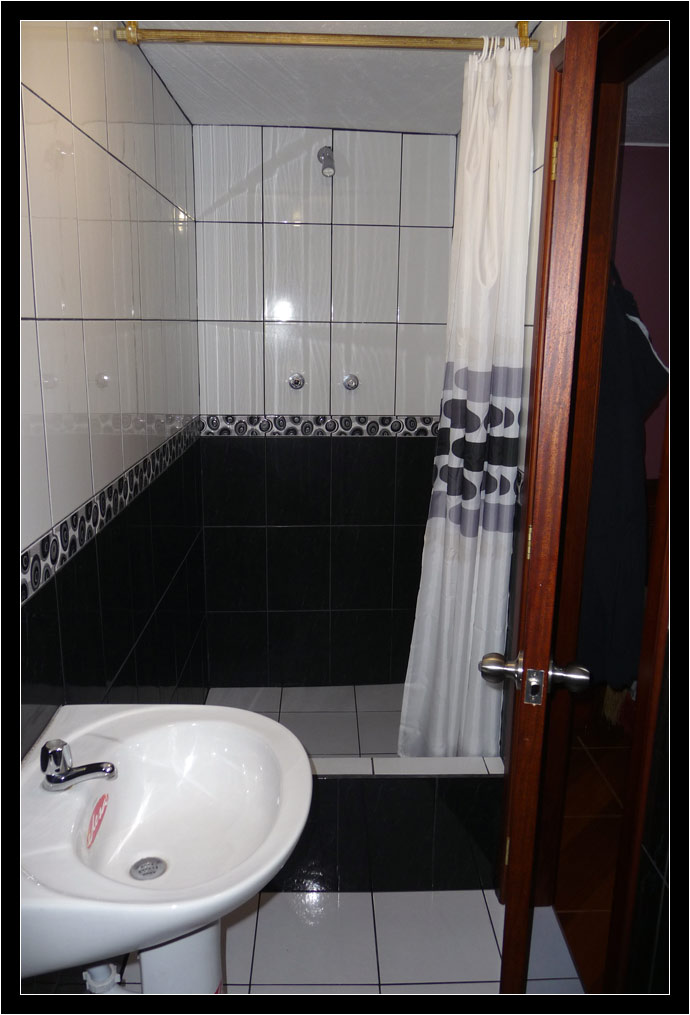
Lunch
While not specific to Ecuador, it’s worth mentioning this lunchtime phenomenon called el menú. It’s basically an executive lunch that comes with three courses and a juice. Say, a soup to start off with, then a plate of chicken or beef always accompanied by rice, french fries, or fried bananas (sometimes all three), and finally a tiny little dessert. There’s usually so much food that we have no hope of finishing it all, but that’s okay because the el menú only costs $1.50 to $3.
As an aside on the restaurant industry: If the place isn’t fancy enough for you to worry about putting on a tie, they probably won’t set the table. Rather than waste time laying out forks, knives, and napkins for you, they’re far more likely to just drop a basket full of silverware on your table and let you do it yourself.
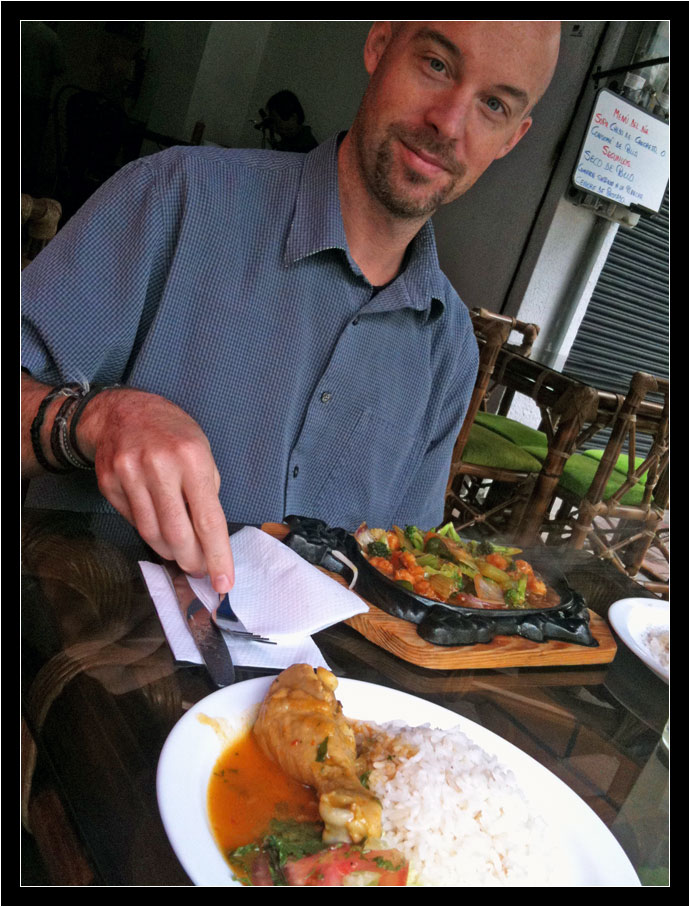
McDonald’s
I try to have something to eat in McDonald’s in every country I visit. I’ve been to at least one in Canada, Mexico, Costa Rica, Venezuela, Peru, Bolivia, Argentina, Australia, Russia, the UK and Amsterdam (if you count airports) and, of course, Ecuador. (The only country I’ve been to that I haven’t been able to go to a McDonald’s is Cuba. I heard rumors that there was one in Guantanamo, but…)
After a month or so in a foreign country, eating foreign food, it can be nice to have a little taste of home, even if that taste is full of preservatives. And there’s almost always a little bit of local flavor on the menu, too. In Ecuador, I tried a Doble McNifica. The McNifica, best I can figure, is Latin America’s McDLT (if you remember that one.) Rather than minced tomatoes and lettuce, you get big, fresh slices. That’s about all that separates it from a Quarter Pounder, really.
One side dish I was excited to try in Ecuador was “choclo,” which basically just means “corn.” Some of the varieties of corn down here are strange to our yellow-sweet-corn ways and I was looking forward to substituting some tasty kernels for the standard french fries. When I pried off the lid of my little plastic tub, I was disappointed to discover that it was the same canned, yellow, sweet corn we get from Del Monte in the supermarket. It was cold, too.
Don’t worry, the dessert made up for it. They have Twix McFlurries down here!
Besides the food (maybe in spite of the food) stopping at McDonald’s is a great idea when traveling. Not only do they almost always have clean bathrooms – with toilet paper! – most of them now have free, open wi-fi, too.
Supermarket Cashiers
Supermarket cashiers in Ecuador get to sit on tall, comfortable chairs or stools in front of their registers. Makes sense. How far do cashiers move in an 8-hour shift? Why not let them sit down? We should be doing that in the States.
Bamboo
You may have heard that bamboo is poised to become a very popular renewable resource. We’re seeing more bamboo products in the States, from kitchen utensils and cutting boards to laminate flooring, but Ecuador is definitely going a step further. They use bamboo in huge construction projects, supporting entire floors of concrete buildings with nothing more than bamboo stalks lashed together. I can’t imagine it’s up to OSHA standards.
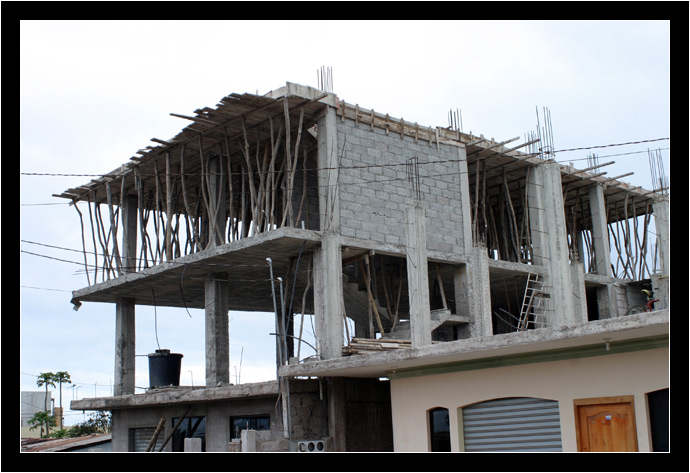
Transportation
To the tourist that just arrives, Ecuador’s roads can be quite scary.
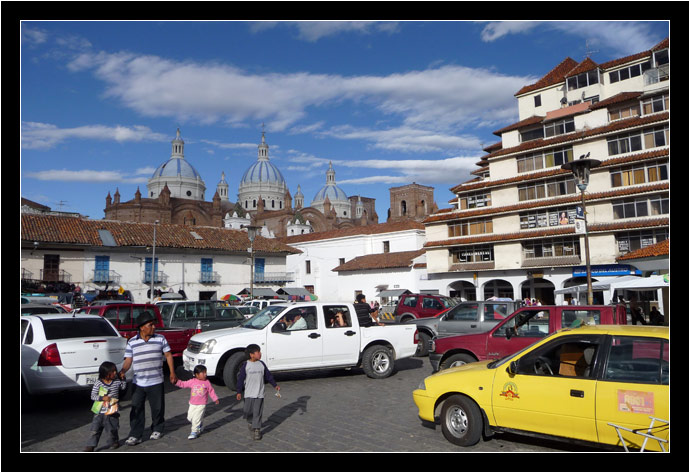
It’s not just that the taxis seem to drive too fast (they do), it’s that there don’t appear to be any rules of the road. Take stop signs, for instance. They seem to be more of a suggestion than a rule. If your cabbie has a wide view of the cross lanes, he probably won’t even slow down as he approaches the intersection. Same goes for stoplights, and doubly so at night.
No one even pays attention to the lanes that are painted on the asphalt. Why drive between the white lines when you can straddle them? That way, nobody can pass you, right?
Once, I thought we were going to be pulled over when our cab first passed a police truck, whose red and blues were flashing, just before blazing through a red light at an empty intersection. They never gave chase. I later realized that the police cars in Ecuador always run with their lights on (if they’re responding to a call, they’ll use the siren) and, well, a red light runner apparently isn’t worth their time.
It took me a long time to figure out what was going on. I kept thinking that if nobody follows the rules, how can there not be an accident at every intersection? It all comes down to some extremely defensive driving. In the US, we’re always very aware of what’s going on in front of us and we pay less attention to the cars in our rearview mirrors. In Ecuador, a driver must know what’s going on around their car all of the time. 360 degree attention, that’s the key!
Speaking of rules being broken, we saw something that just floored us during a big, week-long celebration in Quito. Late at night, a sort of semi-truck pulling a flatbed trailer with a billboard advertising some alcoholic beverage on it was navigating bumper-to-bumper traffic in Mariscal Sucre. From a second-floor restaurant window, we watched two scantily-clad girls on the flatbed call out to pedestrians on the street and offer them free shots. Believe it or not, they were handing shots out to passing cars, too!
Buses
When I first arrived in Ecuador, years ago, I was struck by the chaos that is their bus system. Pretty much everyone takes the bus, and you can tell this is true because they are all on your bus.
There’s an interesting twist with the Ecuadorian buses and I don’t know if it’s a holdover from a time when all the buses were tiny private enterprises or what, but I haven’t really seen it elsewhere. In addition to the bus driver, every bus also has a… well, I always thought of them as “town criers,” but I heard someone else refer to them fondly as “helpers.” Let’s call them “conductors.”
Back in 1998, I don’t think there were any bus terminals in Quito yet, so it was very important that these conductors hang out the door of their bus and yell to people standing on the sidewalks. How else would they know where the bus was going? You’d hear “AmbatoAmbatoAmbato!” followed a few seconds later by “QuitoQuitoQuito!” In some ways, it was an elegant system. You just listened for your destination and then hopped on! It didn’t matter how long the bus ride was, 15 minutes or 8 hours, the bus would slow down near any loitering pedestrian and so the crier could yell out the destination.
You can imagine how much longer than necessary those bus rides were.
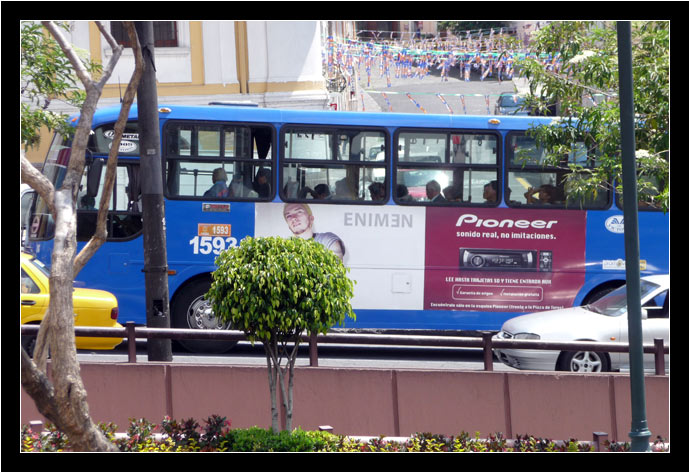
On the open road, the conductor would have to find the time, too, to walk the length of the bus to collect the fares. (At first, I thought it would be easier to do this as people boarded the bus, but then I realized that would slow the transit time even more.) So the conductor would have to remember who got on the bus since the last collection, and then, because everyone got on and got off at different destinations, he must also keep a running list of prices in his head. A good memory is probably a job requirement.
The good news is that most of these conductors keep a sharp eye out for us tourists. Remember, most places still don’t have bus stations, so it can be easy to miss your stop when the bus just pulls up to the curb in an unrecognizable town. The conductors almost also give you a tap on the shoulder (or at least a shout from the front of the bus) to let you know when it’s time to get off.
I’m happy to report that the situation in Quito is much improved since 1998. There are two main bus terminals in the city, north and south, and if you’re departing for points south, you simply go to that terminal. Inside the terminal, all the companies are divided up by the regions they serve and schedules (and sometimes prices) are listed up front. Of course, the conductors are roaming the halls of the terminal now, yelling “AmbatoAmbatoAmbato!”
Another quirk of the Ecuadorian bus system is that they allow vendors to climb on the bus, too. At any given stop, someone might hop on selling ice cream, sodas, banana chips, or a meal of chicken and corn. Others may try to sell bootleg music CDs, or jewelry, or just to give a long, passionate speech about how your donations could help out some orphan kids in need. The bus doesn’t necessarily stop while these vendors roam the aisles. They simply get off when the bus picks the next person up and, presumably, repeat the process going in the other direction.
All this makes for bus rides that seem to go on forever. In fact, I’ll bet that all those busses pulling over to pick up and drop off people slows down the entire transportation infrastructure of Ecuador. It’s not just the buses and their passengers that arrive later than need be. It’s all the cars and trucks that are forced to slow down behind them, too.
And finally…
Garbage Trucks
How do you know when to take your garbage out to the curb? When you hear the twinkling, happy music that the garbage truck plays from its loudspeakers! Just like an ice cream truck in the States.
You can’t imagine how disappointing this can be.

Fun post. I especially like this in addition to the videos. About the relationship between exchange rates and prices, as you pointed out, it really makes no difference. You could have a high or low rates of exchange between two currencies, and prices behaving in opposite ways. Kind of an interesting concept: PPP.